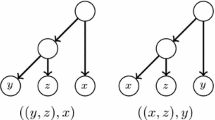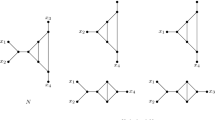Abstract
Phylogenetic networks have gained attention from the scientific community due to the evidence of the existence of evolutionary events that cannot be represented using trees. A variant of phylogenetic networks, called LGT networks, models specifically lateral gene transfer events, which cannot be properly represented with generic phylogenetic networks. In this paper we treat the problem of the reconstruction of LGT networks from substructures induced by three leaves, which we call tri-LGT-nets. We first restrict ourselves to a class of LGT networks that are both mathematically treatable and biologically significant, called BAN-LGT networks. Then, we study the decomposition of such networks in subnetworks with three leaves and ask whether or not this decomposition determines the network. The answer to this question is negative, but if we further impose time-consistency (species involved in a later gene transfer must coexist) the answer is affirmative, up to some redundancy that can never be recovered but is fully characterized.











Similar content being viewed by others
References
Baroni M, Semple C, Steel M (2005) A framework for representing reticulate evolution. Ann Comb 8(4):391–408
Baroni M, Semple C, Steel M (2006) Hybrids in real time. Syst Biol 55(1):46–56
Cardona G, Llabrés M, Rosselló F, Valiente G (2009a) Metrics for phylogenetic networks i: generalizations of the robinson-foulds metric. IEEE/ACM Trans Comput Biol Bioinform (TCBB) 6(1):46–61
Cardona G, Pons JC, Rosselló F (2015) A reconstruction problem for a class of phylogenetic networks with lateral gene transfers. Algorithms Mol Biol 10(1):28
Cardona G, Rossello F, Valiente G (2009b) Comparison of tree-child phylogenetic networks. IEEE/ACM Trans Comput Biol Bioinform 6(4):552–569
Doolittle WF, Bapteste E (2007) Pattern pluralism and the tree of life hypothesis. Proc Nat Acad Sci 104(7):2043–2049
Felsenstein J (2004) Inferring phylogenies, vol 2. Sinauer Associates, Sunderland
Francis AR, Steel M (2015) Which phylogenetic networks are merely trees with additional arcs? Syst Biol 64(5):768–777
Gambette P, Huber KT (2012) On encodings of phylogenetic networks of bounded level. J Math Biol 65(1):157–180
Habib M, To T-H (2012) Constructing a minimum phylogenetic network from a dense triplet set. J Bioinform Comput Biol 10(05):1250013
Hao W, Golding G (2004) Patterns of bacterial gene movement. Mol Biol Evol 21(7):1294–1307
Hotopp JCD (2011) Horizontal gene transfer between bacteria and animals. Trends Genet 27(4):157–163
Huber KT, Moulton V (2013) Encoding and constructing 1-nested phylogenetic networks with trinets. Algorithmica 66(3):714–738
Huber KT, van Iersel L, Kelk S, Suchecki R (2011) A practical algorithm for reconstructing level-1 phylogenetic networks. IEEE/ACM Trans Computat Biol Bioinform (TCBB) 8(3):635–649
Huber KT, van Iersel L, Moulton V, Scornavacca C, Wu T (2017) Reconstructing Phylogenetic level-1 networks from nondense binet and trinet sets. Algorithmica 77(1):173–200
Huber KT, van Iersel L, Moulton V, Wu T (2015) How much information is needed to infer reticulate evolutionary histories? Syst Biol 64(1):102–111
Huson DH, Rupp R, Scornavacca C (2010) Phylogenetic networks: concepts, algorithms and applications. Cambridge University Press, Cambridge
Huson DH, Scornavacca C (2011) A survey of combinatorial methods for phylogenetic networks. Genome Biol Evol 3:23–35
Kelk S, van Iersel L, Lekic N, Linz S, Scornavacca C, Stougie L (2012) Cycle killer.. qu’est-ce que c’est? on the comparative approximability of hybridization number and directed feedback vertex set. SIAM J Discret Math 26(4):1635–1656
Martin DP, Murrell B, Golden M, Khoosal A, Muhire B (2015) RDP4: detection and analysis of recombination patterns in virus genomes. Virus Evol 1(1):vev003
Martin WF (2011) Early evolution without a tree of life. Biol Direct 6:36
Moret BM, Nakhleh L, Warnow T, Linder CR, Tholse A, Padolina A, Sun J, Timme R (2004) Phylogenetic networks: modeling, reconstructibility, and accuracy. IEEE/ACM Trans Computat Biol Bioinform (TCBB) 1(1):13–23
Morrison DA (2011) Introduction to phylogenetic networks. RJR Productions, Stamford
Nikolaidis N, Doran N, Cosgrove DJ (2014) Plant expansins in bacteria and fungi: evolution by horizontal gene transfer and independent domain fusion. Mol Biol Evol 31(2):376–386
Oldman J, Wu T, van Iersel L, Moulton V (2016) TriLoNet: piecing together small networks to reconstruct reticulate evolutionary histories. Mol Biol Evol 33(8):2151–2162
Polz MF, Alm EJ, Hanage WP (2013) Horizontal gene transfer and the evolution of bacterial and archaeal population structure. Trends Genet 29(3):170–175
Seehausen O, Terai Y, Magalhaes IS, Carleton KL, Mrosso HD, Miyagi R, van der Sluijs I, Schneider MV, Maan ME, Tachida H et al (2008) Speciation through sensory drive in cichlid fish. Nature 455(7213):620–626
Semple C, Steel MA (2003) Phylogenetics. Oxford University Press on Demand, Oxford
van Iersel L, Kelk S (2011) Constructing the simplest possible phylogenetic network from triplets. Algorithmica (New York) 60(2):207–235
van Iersel L, Kelk S, Rupp R, Huson D (2010) Phylogenetic networks do not need to be complex: using fewer reticulations to represent conflicting clusters. Bioinformatics 26(12):i124–i131
van Iersel L, Moulton V (2014) Trinets encode tree-child and level-2 phylogenetic networks. J Math Biol 68(7):1707–1729
Willson S (2011) Regular networks can be uniquely constructed from their trees. IEEE/ACM Trans Comput Biol Bioinform (TCBB) 8(3):785–796
Acknowledgements
The authors would like to thank the anonymous reviewers for many comments and suggestions that helped to improve the quality of the manuscript.
Author information
Authors and Affiliations
Corresponding author
Additional information
Partially supported by the Spanish Ministry of Economy and Competitiveness and European Regional Development Fund project DPI2015-67082-P (MINECO/FEDER).
Rights and permissions
About this article
Cite this article
Cardona, G., Pons, J.C. Reconstruction of LGT networks from tri-LGT-nets. J. Math. Biol. 75, 1669–1692 (2017). https://doi.org/10.1007/s00285-017-1131-8
Received:
Revised:
Published:
Issue Date:
DOI: https://doi.org/10.1007/s00285-017-1131-8




